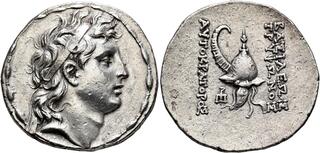| Leu Numismatik AG > Auction 15 | Auction date: 1 June 2024 |
| Lot number: 142 Price realized: This lot is for sale in an upcoming auction - Bid on this lot  | Show similar lots on CoinArchives Find similar lots in upcoming auctions on |
| Lot description: SELEUKID KINGS. Tryphon, circa 142-138 BC. Tetradrachm (Silver, 31 mm, 16.52 g, 1 h), Antiochia on the Orontes. Diademed head of Tryphon to right. Rev. BAΣIΛEΩΣ / TPYΦΩNOΣ - AYTOKPATOPOΣ Spiked Macedonian (or Cretan?) helmet with cheek guards to left, adorned with wild goat's horn above visor; in inner left field, monogram. CSE 254. SC 2029a. SMA -. Of the highest rarity without wreath on the reverse. A coin of great beauty with a wonderful portrait of the usurper. A few scattered light marks, otherwise, about extremely fine. Ex Leu Web Auction 14, 20 December 2020, 577 and previously from a German collection, formed in the 1960s. Tryphon, a former strategos of Demetrios I and Alexander I Balas, assumed a pivotal role in Seleukid politics when he appointed the two-year-old Antiochos VI as king in 144 BC, subsequently serving as his tutor and protector. During this guardianship, a significant event unfolded as the Jews, led by Simon Thassi, successfully seceded from Seleukid authority following Tryphon's capture and execution of Simon's brother, Jonathan Apphus, in 143 BC. Upon the death of Antiochos VI in 142/1 BC, Tryphon seized the kingship for himself. However, his reign was short-lived as he faced defeat and eventual death at the hands of Antiochos VII in 138 BC. The emergence of the helmet motif on Seleucid coinage marks an intriguing development. Initially appearing in 143/2 BC on a drachm of Antiochos IV, featuring the inscription TPY between the spike and horn on the reverse, this motif became the primary coin type under Tryphon's rule. While conventionally described as a Macedonian helmet, K. Ehling has proposed an alternative interpretation, suggesting it may actually depict a Cretan helmet, possibly alluding to the presence of Cretan mercenaries within the Seleukid army, a great number of which arrived with Demetrios II in Syria in 147 BC. If substantiated, this iconographic choice suggests Tryphon's dependence on these foreign mercenaries, possibly due to their greater willingness to support a usurper compared to the regular Seleukid soldiers, who typically hailed from Macedonian military colonies in Syria and thus held stronger allegiance to the legitimate Seleukid dynasty. Estimate: 5000 CHF |  |



